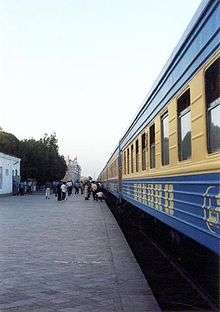Transport in Uzbekistan
As of 2007, Uzbekistan's overland transportation infrastructure had declined significantly in the post-Soviet era due to low investment and poor maintenance. Air transport was the only branch that has received substantial government investment in the early 2000s, as airport modernization projects have been undertaken.[1] In the following years, improvements have been made to the surface transport network including the construction of the Tashkent–Samarkand high-speed rail line.
Railways

As of 2008, Uzbekistan had 3,645 kilometers of rail lines, about 620 kilometers of which were electrified. A large percentage of the system’s track requires major repair. The main line is the portion of the Transcaspian Railroad that connects Tashkent with the Amu Darya. There are rail links with Kazakhstan, Kyrgyzstan (see Trans-Caspian Railway), Tajikistan, Afghanistan, and Turkmenistan. Suburban traffic only exists around Tashkent.
The Tashkent–Samarkand high-speed rail line; a line upgraded to high speed operation started operation in September 2011.[2] Uzbekistan has links to Moscow, Ufa, Chelyabinsk, Novosibirsk, Saratov, Penza and Saint Petersburg (via Kazakhstan) and Kharkiv (via Kazakhstan and Russia). From Almaty connecting trains are provided to Urumchi in China. Also Tajik trains of Dushanbe-Moscow (No: 319), Moscow-Dushanbe (No: 320), Khujand-Saratov (No: 335), Khujand-Atyrau (No: 335), Saratov-Khujand (No: 336), Khujand-Moscow (No: 359), Moscow-Khujand (No: 360), Kanibadam-Kurgonteppa (No: 389), Kurgonteppa-Kanibadam (No: 389) and Atyrau-Khujand (No: 692) passes from Uzbekistan.
With only one change of trains in Moscow you can travel overland from Central and Western Europe (Berlin, Cologne, Vienna, Prague, Budapest, Helsinki, etc.) to Tashkent and vice versa.[3]
The Tashkent Metro was the only such line in Central Asia.,[1] until the opening of the Almaty Metro. Last development projects are detailed in Uzbekistan Railways website: http://www.uzrailway.uz
Maps
Highways
As of 2005, Uzbekistan had 84,400 kilometers of roads, about 72,000 kilometers of which were paved. The road infrastructure is deteriorating, particularly outside of Tashkent. No significant highway projects were underway in 2006. In the early 2000s, U.S. engineers improved some roads around the port of Termez to facilitate movement of humanitarian supplies to Afghanistan. Uzbekistan is a member country of the United Nations’ Asian Highway Network, and several national roads are designated as part of the network.[1]
There are some parts of the roads considered as freeways, although mostly in a state of complete neglect and disrepair since the collapse of the Soviet Union. The ring road around Tashkent is about 70 km. long, and completely multilaned, although it lacks a carraigeway separation in most sections. The M-39 road, connecting Tashkent and Samarkand is a 4-laned road in some 300 kilometers of its length, although poorly maintained and without carriageway separation in most of its length.
Ports and waterways
Double landlocked Uzbekistan has no seaports. Its main river port is Termez on the Amu Darya river. Although Termez lacks modern facilities and has a shortage of spare parts, activity there has increased as conditions in neighboring Afghanistan have stabilized. Termez has been an important transfer point for humanitarian supplies entering Afghanistan.[1]
Uzbekistan has 1,100 kilometers of inland waterways. Since the mid-1990s, commercial travel on Uzbekistan’s portion of the Amu Darya has been reduced because of low water levels.[1]
Pipelines
As of 2010, Uzbekistan had 10,253 kilometers of natural gas pipelines, 868 kilometers of oil pipelines, and 33 kilometers of pipelines for refined products.[1]
Airports
As of 2012, Uzbekistan has 53 airports. 33 of them have paved runways, six of which had runways longer than 3,000 meters. The largest of them, Tashkent International Airport, is linked with European and Middle Eastern cities by direct flights of Aeroflot, Lufthansa, and Turkish Airlines, and with New York and Los Angeles via connecting flights through Moscow. The national airline, Uzbek Havo Yollari (Uzbekistan Airlines), flies mainly within the former Soviet Union.[1]
See also
- North-South Transport Corridor
- Ashgabat agreement, a Multimodal transport agreement signed by India, Oman, Iran, Turkmenistan, Uzbekistan and Kazakhstan, for creating an international transport and transit corridor facilitating transportation of goods between Central Asia and the Persian Gulf.[4]
References
- 1 2 3 4 5 6 7 Uzbekistan country profile. Library of Congress Federal Research Division (February 2007). This article incorporates text from this source, which is in the public domain.
- ↑ High-speed Afrosiyob train starts to run between Tashkent and Samarkand, 6 October 2011
- ↑ http://uzbekistan-railway.blogspot.com/
- ↑ The Hans India - India accedes to Ashgabat agreement